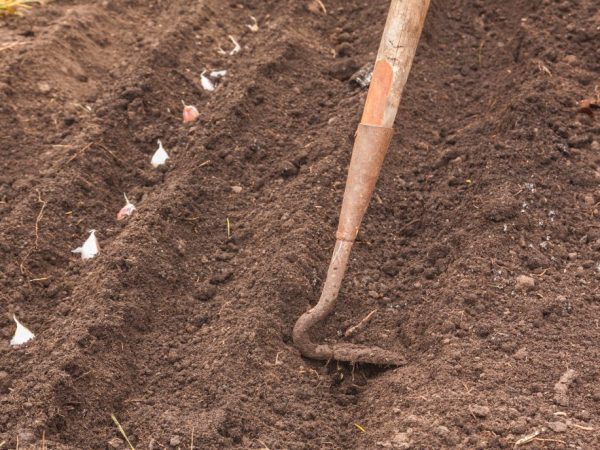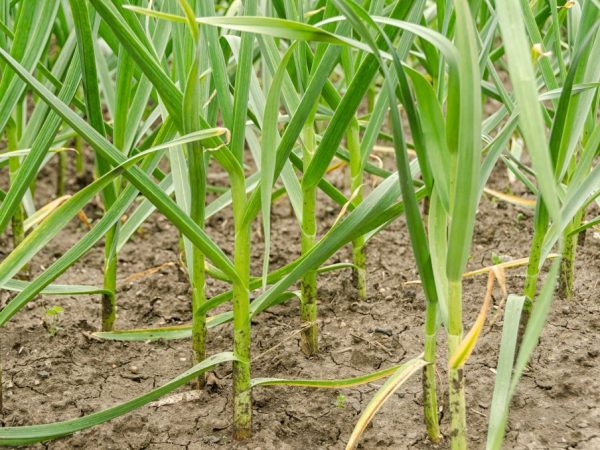How to plant and grow garlic
Knowing the peculiarities of growing plants, it is easy to get a rich harvest from the most modest variety. With proper cultivation, it is difficult to make a mistake, so farmers are attentive to all stages of plant development. How is garlic planting and what needs to be done next?

How to plant and grow garlic
Preparatory procedures
A bountiful harvest is the merit of an attentive gardener who properly cares for the plantings. In order to grow your favorite culture without problems, preliminary events are carried out in autumn and spring.
Plot
A popular spice is a light-loving plant, therefore, open solar beds, where there are no closely adjacent underground waters, are chosen as the main development site. The spice is demanding on the soil and prefers to grow on loamy or sandy loamy soils with neutral acidity. A vegetable cannot be planted in one place for several years in a row.
Predecessors
The best precursors for garlic are:
- peas;
- beans;
- cabbage;
- pumpkin.
Garlic can be returned to its original place of planting no earlier than after 4-6 years.
Neighbors
On one hundred square meters, it is difficult to allocate a lot of space for the beds, so you have to think about a successful neighborhood. Joint plantings of garlic are arranged next to gooseberries and black currants, they also will not harm strawberries and raspberries. The seal is approved for:
- potatoes;
- tomatoes;
- cucumbers;
- Luke.
Fertilizers
The next stage in the preparation of the site begins in August, when the crop is harvested. So that the place does not stand idle for a long time, it is sown with siderates until autumn. At the end of September or in October, organic fertilizers (humus, compost) are applied for digging. When forming beds in the spring, remove plant residues and add:
- wood ash;
- superphosphate;
- nitrophosphate.
Seed material
To get a bountiful harvest, it is important to select the right cloves. Damaged and sluggish specimens will rot, become a source of disease in the ground, so they cannot be used for reproduction. Raw materials are carefully disassembled and carefully examined.
Before agricultural work, the heads are immersed for 120 seconds in a saline liquid. To protect the planting of garlic from diseases, the seeds are soaked for 30 minutes in a pink solution of potassium permanganate or 1% copper sulfate. This procedure will destroy bacteria and protect the seed from death. After preventive treatment, the raw materials are washed and they begin to plant them on the beds.
How to plant
An unsuitable date or non-observance of the technology of planting a crop will destroy even the strongest varieties.

Do not bury the cloves of garlic deeply.
Optimal timing
How to determine favorable days for planting garlic? It is customary to plant a healthy vegetable twice a year - in autumn and spring. It is better to bury winter plants in the ground in September and October: the cloves will have time to take root, but will not waste nutrients for the development of greenery. Later work can lead to freezing of raw materials.
For spring species, the best period is mid to late spring. It is important that the soil temperature warms up to 7 ° C. For the Stavropol Territory, this period begins in April, for the Middle Belt - in May, and for Novosibirsk - not earlier than June or July.
The timing of planting garlic for each region is different, so they look at the annual weather statistics without being tied to numbers. According to the sowing calendar, agricultural work should be started on the waning moon.
Planting in winter
Growing winter spices allows you to get a more abundant harvest than in the spring version. Warm weather can provoke mass germination and further death of seedlings during the first frost. The optimum soil temperature is 13-15 ° C.
In order for the earth to settle, the beds are prepared 2 weeks before the start of work. On the day of planting the garlic, it is necessary to prepare furrows, the bottom of which is covered with 2 cm of a mixture of earth and coarse sand. Such a cushion protects the seed from contact with the soil and prevents the activation of rotting.
The planting scheme for winter garlic assumes that the distance between the rows is 25 cm, and between the plants - from 8 cm to 15 cm. When planting cloves, a deeper hole is recommended than when planting spring options. There should be at least 0.2 m of soil above the crops, each bed is mulched with sawdust and peat. If there is no rain, the area is watered abundantly.
How to plant garlic with air caps? Sowing bulbs takes place at the same time as sowing large seeds. The plant is buried to a depth of at least 3 cm, a distance of 10 cm remains between the seedlings. In the spring they wake up faster and enter the vegetative period, and by the next year a full harvest ripens in the summer.
Planting in spring
It is necessary to plant spring garlic at a time when the soil temperature warms up to 7 ° C. The denticles develop at a certain humidity of the earth, therefore, in the absence of precipitation, the site must be watered. Planting is carried out according to the scheme:
- depth - 15 cm;
- the distance between the holes is 10 cm;
- the gap between the rows is 18 cm.
If you plant the garlic correctly, the first shoots will appear after a few days. For germination, a temperature of 10 ° C is required. Spring plants are not afraid of frost, although in regions with very cold spring they are advised to cover them with foil at night. Mulching saves from the vagaries of nature and makes it easier to care in the future.
How to care
It is not enough just to plant perennial garlic, you need to be able to choose the right cultivation measures. Violation of agricultural technology can destroy seedlings at any stage of development.

Garlic needs watering and feeding
Irrigation
Bulbous plants, which include a favorite spicy vegetable, respond to watering with trepidation. It is important to carry out the moisturizing procedure correctly, without exceeding the permissible rate and without provoking drought. With a shortage of water, gray spots with a white tint appear on the feathers of the seedlings, and the tips are bent. Excess is dangerous at all stages of development: in the early stages it causes rotting of underground parts, and before harvesting it reduces the keeping quality of products.
If we are planting homemade garlic, we cannot hold the event in dry soil. Before work, the site must be irrigated, giving several hours for assimilation. You cannot water the plants with cold water, otherwise you can provoke the appearance of a fungus.
To grow healthy garlic, you need to hydrate every week from the end of April to June. Already in July or during a cold summer, the interval between events is increased to 9 days. The secret of care lies in the fact that diverter ditches are placed between the rows to prevent liquid stagnation.
On average, 1 sq. m use from 6 to 9 liters of water. In regions where there are many hot days a year, the volume of liquid is allowed to be increased by 1-3 liters. Irrigation is stopped 3 weeks before harvest: in July for winter crops and in August for spring species.
Loosening
If you decide to plant garlic at home, remember that the plant prefers to thrive in a well-aerated environment. After heavy rainfall during the heat, a strong layer is formed on the ground, which is almost impermeable to oxygen. A thick soil crust is an excellent breeding ground for disease and rot.
In order not to damage the roots, loosening is carried out to a shallow depth - from 1 to 3 cm. The procedure is repeated after each heavy rain or before regular watering. Before actions, weeds are removed, trying not to disturb the seedlings. Caring for the garlic makes it easier to mulch with sawdust.
Top dressing
The abundance of organic matter and nitrogen-containing agents provokes an increase in shoot growth. This feature leads to a decrease in head formation and is suitable for growing crops on a young feather.
If we plant winter garlic, it is better to use preparations based on potassium and phosphorus as top dressing. Trace elements improve cold resistance, which helps during wintering. In spring, seedlings can be fertilized with ammonium nitrate and superphosphate.
Three mandatory entries are recommended:
- 10 days after spitting seeds;
- after 2 weeks;
- when the heads grow from a walnut.
Disease and pest control
The most dangerous ailments are bottom rot and bacteriosis. Diseases affect the plant during storage and enter the site with seeds. Initially, the tops of vegetables brighten, after all the feathers die off. To prevent ailment, it is better to harvest after the final ripening.
If you plant the garlic incorrectly, there is a danger of rust infection. Small spots of brownish-orange color cover the plate and transfer to the stem. At the slightest suspicion of a disease, the culture is treated with fungicides ("Radomil", "Ordan", "Ohsiom").
Onion fly is the most common pest. The larvae of the parasite live and feed on the heads, which is why the culture withers and dies. Plantings are watered with tobacco solution, wood ash is poured nearby. To avoid the appearance of nematodes on the beds, calendula and chicory are planted nearby.
To get the heads whole, it is advised to plant resistant garlic. For example, the Parus variety has a good immunity to rot and fungi, and is also not like insects. Before starting agricultural work, preventive spraying of the site is carried out and do not forget about compliance with the cultivation technology.
Harvesting
After the plant has reached maturity, they start harvesting. They switch to digging only when the shells of the air capsules begin to burst. Another notable sign is the lack of young feathers. If you are late with harvesting, the heads will disintegrate into slices.
If you plant garlic for the winter, they start harvesting in July. Spring varieties ripen in autumn: from the second half of August to the first 10 days of September. Water irrigation is stopped 3 weeks before the event. The day of harvesting should be sunny, dry weather.
With a pitchfork, a shovel or an automatic device, they slowly dig the plant out of the ground, trying not to damage the roots. Shake gently, getting rid of soil residues. The crop is dried together with the tops on the street under a canopy or in a well-ventilated area for 5 days. Then the roots are removed, the stem is cut off next, leaving a 10 cm tail. Storage takes place in a temperature regime from 4 ° C in the refrigerator to 20 ° C in an apartment.
If you understand the requirements of cultivated plants, the cultivation process will go smoothly. Planting garlic using the technology will allow you to get a rich harvest.


